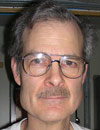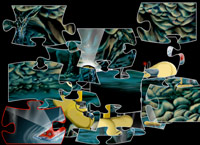|

 Today's Weather Mostly sunny Lat: 04° 32’S Long: 12° 34’W Air Temp: 78.6°F Bar Pressure: 1009.9 mbar Sea Temp: 79.7°F Sea State: 5-8 ft Swell Height: <7 ft, SE Wind: ESE; 13-15 knots Visibility: Unlimited
Two Robotic Cats “Talk” Under Water In the brutally early morning hours, we had our last chance to run our most challenging engineering test: putting two underwater autonomous vehicles in the water at the same time to navigate and communicate with each other, and with our research vessel Knorr. At the same time, they needed to complete simple missions. Jaguar was the first to dive down 400 meters (0.25 miles) from the surface. It was programmed to drive one time around a square measuring 300 meters (984 feet) on each side. While Jaguar was on its descent, the team launched Puma to the same depth but 200 meters (656 feet) away from Jaguar. Puma was programmed to drive twice around a square of the same size. The vehicles succeeded in sending data packets to and from each other and the ship. Roughly three hours later, they ascended to the surface, one after the other, and were both safely back on Knorr as the dawn began to light the horizon. “We have demonstrated the technology for simultaneous communication and navigation in the deep ocean,” said engineer Louis Whitcomb on the final day of the expedition. He called the success a modest step in the direction of larger scale surveys. The engineering team still needs to analyze the information that was communicated between the AUVs and the ship. For now, they are extremely happy to have accomplished a major cruise objective—integrating acoustic (sound) communications on to deep water vehicles. “We are coming to grips with using multiple vehicles on a scientific mission,” said chief scientist Hanu Singh. Furthermore, “we are not often able to do engineering development in the context of doing real scientific research [like searching for hydrothermal vents], and we got good data for both.” Geophysicist Rob Reves-Sohn is primarily interested in mid-ocean ridges and hydrothermal vents, but he also has an engineering background—so he appreciated the technical progress made on the expedition. “It was like a choreographed dance,” he said. “The steps were created, the two AUVs programmed, and then they both went underwater to dance together. I think we did an excellent job of developing our knowledge of the site. We now know that this is a very unusual site for a high-temperature vent field. The main geological features are formed by faulting instead of volcanic eruptions, and the basin is very deep. We need to come back and stage a full-scale scientific expedition to understand these puzzles.” And finally, we recognize the early part of our cruise that was so crucial in narrowing our search area: the CTD tow-yos. Before geologist Ko-ichi Nakamura came on the cruise, he promised Hanu that he would complete the CTD survey in as short a time as possible so as to maximize the time available for the AUV missions. “I think we proved that we can locate hydrothermal targets with the CTD, optical backscatter and Eh sensors without collecting water and chemically analyzing it on board,” Ko-ichi said. “Once the Eh anomaly is detected in the buoyant plume, then we can narrow the target search area for the hydrothermal plume by doing just one or two more tow-yos.” Now the lab is a beehive of activity as we pack up our equipment in a shipping container and prepare to get our “land legs” again after three weeks at sea. Our equipment will stay on the ship until Knorr reaches Charleston, South Carolina, when it will be off-loaded and sent by truck back to Woods Hole in mid-February. Tomorrow, our science and engineering teams will disembark at Ascension Island, a volcanic island renowned in part for its seabird population and for its endangered green sea turtles. Three of us in the science party will take a night flight on a Royal Air Force flight to Oxford in the United Kingdom. The rest will spend five days on Ascension and will then take a US military flight to Florida. (Flights only leave Ascension once each week). From Florida, everyone flies to their respective homes. We hope you have enjoyed our adventure with Puma and Jaguar on the southern Mid-Atlantic Ridge. Stay tuned to find out when Dive and Discover will join another research expeditionRead the interview

Dan Conrad: Dan Conrad, who has taught physics for more than 20 years at Baltimore Polytechnic Institute, has a lifelong passion for both science and art. Read the interview »
[ Previous day ]
|
||
Mailing List | Feedback | Glossary | For Teachers | About Us | Contact
© 2010 Dive and Discover™. Dive and Discover™ is a registered trademark of Woods
Hole Oceanographic Institution



